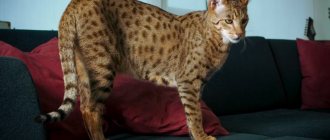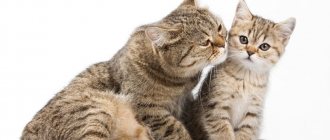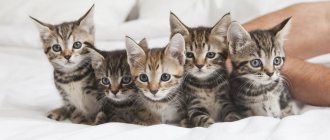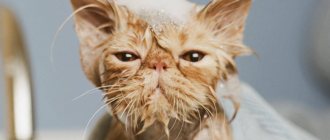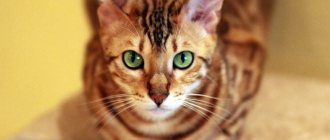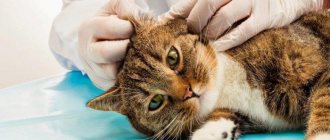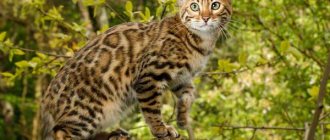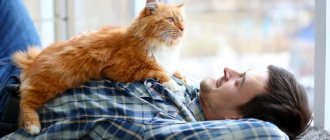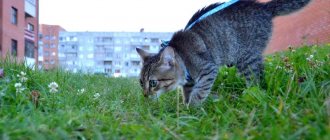People have long surrounded themselves with pets - helpers in everyday life and breadwinners. Observing their behavior also helped to learn about changes in the atmosphere. Among animals close to humans, the undisputed leader in the accuracy of weather determination is the cat.
The lucky owners of furry weather forecasters do not need to look into smartphone applications, study meteorological sites on the Internet, or watch guide forecasts on TV. It is enough just to be attentive to your pet.
How cats predict the weather
Pets are sensitive to weather changes, but scientists have not yet figured out the specifics of this process. It is believed that the sensitive vestibular apparatus of the cat plays an important role. The eardrum senses changes in atmospheric pressure and air humidity, so the fluffy behaves differently.
Cats that spend a lot of time outdoors predict the weather more accurately than their indoor counterparts. The worst weather forecasters are cats without fur. Sphinxes sleep in a ball under a blanket in cold, rain, and heat.
How to predict worsening weather conditions
When a cat feels that the weather is getting worse, it carefully cleans its ears and... its right leg. In addition, it begins to scratch surfaces: furniture and carpets. A sign of impending rain can also be a kitten sneezing and snoring. Animals avoiding walks is also a clear sign that the weather outside may soon turn bad. Interestingly, if a cat purrs very loudly in the fall, the winter must be long and harsh.
In addition, the location of the furry's body and head during a nap can indicate whether a cyclone should be expected. For example, if a four-legged friend is lying on his back, and his head and face are turned up, a storm should be expected.
A simple underground cooler for drinks from water pipes: instructions
Juicy sandwich cake for tea: carrot sponge cake and a layer of airy cream
2 stories about children's ingenuity: my daughter was playing and the ball hit the table
To the cold and frost
If the temperature outside the window is approaching a drop, the cat will look for a warm place in advance. The pet will sit comfortably on the radiator, by the fireplace, stove or on the lap of its beloved owner. A non-flat TV or a sofa with a soft blanket would also be a good option.
The posture of a cat in a dream will also be a signal of the imminent onset of cold weather. He will definitely curl up and cover his nose with a warm paw.
What weather changes do cats show?
- Cold weather - the cat lies down in a warm place, on a rug closer to the stove, fireplace, radiator or on the radiator itself, on the bed under a blanket, if allowed, and asks to be held by the owner. At the same time, it curls up and covers its face with its paws - in anticipation of cold weather, it accumulates heat.
- Windy weather – before a blizzard, blizzard, or strong wind, the cat sleeps restlessly, often changes position in its sleep, and fidgets around in search of a better place. May nervously scratch the floor, carpet, wall, pillows, upholstery and special items for this purpose.
- Rainy weather – the cat has an unquenchable thirst, she drinks a lot, sneezes, does not want to go outside, diligently licks herself with her tongue, licks her tail for a particularly long time, scratches her ears with her paws, and eats grass with pleasure. If licking occurs against the growth of the fur, it is very likely that there will be hail. And excitement, fast, sharp movements of the pussy - lead to a thunderstorm.
- Warming, clear weather - the cat stretches out imposingly on the floor, sleeps soundly on its back, spreads its paws to the sides in its sleep, this increases the heat transfer of its body. Slowly and calmly he washes himself, stretches, and yawns. Loves to sit on the windowsill or balcony and watch what is happening outside the window.
- A sharp change in the weather - the cat sleeps a lot and for a long time, intensely scratches everything, no matter what change is approaching: from warm to cold or vice versa.
- Change in atmospheric pressure determined by the cat's pupils. Constriction of the pupil means a decrease in atmospheric pressure; an increase is signaled by a dilated pupil.
- Serious natural phenomena such as severe storms, volcanic eruptions, tsunamis, tornadoes and the like cause real panic in cats. They meow loudly, spin like a top on the floor, do not sit in one place for a second, jump on a chair, table, try to run away from the house or huddle close to the owner. In these cases, it is worth finding out what is expected in nature from more reliable sources.
There are known cases when cats warned their owners about the beginning of an earthquake and people managed to take the necessary measures. According to maritime tradition, sailors take a cat on board a ship, it warns of an impending storm.
The features that nature has endowed cats with benefit people, and for this we are grateful to them.
Towards warming and heat
When the thaw begins, the cat will want to straighten up from its ball. The body will roll over onto its back and form an arch. If hot weather is approaching, the cat will spread its paws in different directions. So pets try to increase their area in order to cool down.
The fluffies no longer care where to sleep - be it on the floor or on the windowsill. It’s not for nothing that the proverb says: when a cat rolls on the floorboards, warmth knocks on the house.
How to determine the weather by a cat: folk signs
Over a century of observations, a lot of knowledge has accumulated on how to determine the weather based on a cat. The behavior and mood of the pet, the place the cat chooses to rest, and body position during sleep, increased thirst and other signs are taken into account. It has been noticed that cats living at home are more sensitive to upcoming weather changes. Any owner of a furry forecaster can independently check the truth of folk signs by observing the behavior of their pet and taking into account the most common signs:
- If a cat sleeps on its back, with its paws spread to the sides, then this foreshadows imminent warming and clear weather (anticipating the heat, the animal tries to increase the area of body heat transfer).
- If a cat curls up in a ball and covers its nose with its tail, then this clearly indicates that cold weather is approaching (this position helps to retain heat).
- On the eve of windy weather or a blizzard, the cat's sleep becomes restless, nervous, she often tosses and turns and changes position.
- Also, before the onset of cold weather, the purr chooses the warmest places in the house to rest - heating radiators, a rug in front of the fireplace, buries itself in a blanket or looks for a warm place near the owner.
- Constriction of the pupil signals a decrease in atmospheric pressure, and a dilated pupil indicates an increase.
- Increased thirst occurs before bad weather.
- Scratching a wall or carpet means bad weather, in winter a blizzard.
- If a cat refuses to go for a walk, intensively licks its tail and rubs its ears with its paws, then most likely the weather will be rainy the next day.
- Calm licking of the paws and fur, especially while sitting with the hind leg straightened, on the contrary, foretells clear weather.
- Nervous licking of a fur coat means bad weather.
- Licking fur against the direction of growth - towards hail.
- Stretching and yawning mean clear sunny weather.
- Nervous, rapid movements, increased activity - a sign of an impending thunderstorm.
- Eating grass means rain.
In the face of impending severe bad weather or natural disasters, cats behave nervously, meow loudly, try to find a secluded place, or, conversely, do not leave their owner.
Towards the rain
You should be afraid of a downpour if your cat refuses to go outside. Whiskers do not like to get their fur wet and carefully avoid it. A lazy and thoughtful cat who doesn't want to play senses the approaching cloudy weather.
Even the pet’s increased thirst and desire to eat grass indicate the imminent onset of rain. This is how cats are affected by changes in atmospheric pressure.
If cold weather is expected...
Many cats have the same reaction to the upcoming drop in air temperature. They lay down near warm objects, take certain poses, for example, curl up in a ball, and begin to ask to be held (if their character allows).
What affects the cat’s body at such moments? Its reaction to the weather is not a prediction, but the result of the animal’s body’s ability to determine upcoming changes in atmospheric pressure based on its precursors.
Certain movements appear in cats when there is a storm, heavy snowfall, or strong winds. The cat rushes around the apartment like a whirlwind, raising its tail like a column, as if panicking. A loud meow and an expressive look are possible. Often she cannot find a place for herself, rushes about, rotates around her axis.
So she tries to predict serious weather forecasts. Similarly, it can “predict” natural disasters: earthquakes, snowstorms, tornadoes. Cat - weather - concepts that are worth linking together.
To the blizzard and storm
If the cat cannot sleep peacefully, constantly fidgets, spins and wakes up, expect disturbance in the elements. Outside of dreams, the mustache will run around the house and jump onto higher objects. Some pets begin to zealously scratch various objects or scratching posts, depending on their upbringing.
A fluffy and carefully licked tail warns of an imminent blizzard. According to popular belief, the wind will blow in the direction in which the cat turns its head while washing itself.
How our ancestors treated cats
From the numerous works of Russian classics, the image of cats is often formed as the embodiment of the devil on earth, the servants of witches and other evil spirits. Is it really?
In part, yes, this idea of four-legged friends came in the era of active use of spiritualism - communication with spirits, the outbreak of which occurred at the end of the 18th - beginning of the 19th centuries. Back then, even live cats were used for some rituals. But was it always like this?
Much earlier, during the times of the ancient Slavs and Kievan Rus, cats occupied their niche in the formation of many folk signs and beliefs. Of course, even then black cats were considered “servants of the evil spirit” and were feared in every possible way, but there was no such excitement around cute animals. The cat was considered a full-fledged resident of the house and the keeper of the family hearth.
To natural disasters
Before hurricanes, earthquakes and tsunamis, cats become anxious. The pets run wildly around the house and try to escape, meowing loudly, as if they want to warn the owner of danger. Some behave the opposite - hide, cry and tremble.
This happens because cats are more sensitive to earth vibrations. During natural disasters, static electricity rises sharply, which frightens animals and forces them to seek shelter.
Did you like the article? Share with your friends!
Examples of weather predictions by cats
A striking example is the case in Oklahoma, where tornadoes are a frequent occurrence. In one family there lived a cat named Sally, her usual day began with playing in the early morning, eating and sleeping during the day. But one sunny day, Sally behaved anxiously, walked around the rooms and corridors, meowing pitifully, the animal tried to get out of the house, scratching the window frame, run out the open door, and hide under the bed. Sally hissed when her owners tried to pet her. The owners paid attention to the pet’s behavior and checked the weather forecast. They learned that another tornado was approaching. Fortunately, the tornado passed by, although it was not without strong winds and rain.
In regions where earthquakes often occur, residents notice sudden changes in the behavior of cats, which before an earthquake begin to meow loudly, tremble, and seek shelter. The appearance of the animals also indicates imminent disaster - tousled fur, ears pressed to the head. Scientists theorize that animals sense an increase in static electricity that precedes an earthquake.
In the 17th and 18th centuries, sailors took cats on board their ships before sailing. With the approaching storm, the cats instinctively tried to find a safe place, anxiously leaving the ship. The sailors observed changes in the animals' behavior and took the unusual weather warning seriously. Sometimes sailors refused to go out to sea if cats escaped from the ship. It was believed that if an animal meows loudly, then a difficult swim is ahead. But the playful behavior of the animals on board the ship indicated an easy journey with good winds. Japanese sailors value individuals of tortoiseshell and white color, which are a kind of amulet against storms. Animals are credited with the ability to calm the storm.
Active drinking and chewing grass before rain
Anticipating the onset of precipitation, the domestic cat begins to increasingly approach the water bowl. At this moment she will not refuse the freshly picked grass. The approaching rain is also indicated by the fact that the cat began to actively lick its tail and wash its ears. Take an umbrella with you when leaving home if your pet sneezes. All these actions (chewing, drinking water, sneezing and licking) reduce tension in the stomach, which is caused by changes in atmospheric pressure.
There have been different times in history. Sometimes cats could even be exterminated for their ability to predict the weather: it was believed that they were the ones who invited terrible hurricanes and heavy downpours. Fortunately, in the modern world, people’s ideas have changed dramatically: representatives of the cat family are not only our friends, but also faithful helpers.
A cat as a weather forecaster: we determine the weather by the pet’s behavior
Lately it has become very difficult to predict the weather even for the next couple of days in order to plan your leisure time, and weather forecasters are often wrong. But this is not a reason to despair if you have a cat at home. How, with the help of a pet, can we determine what awaits us in the near future - warming or, on the contrary, cooling? Watch him, pay attention to what he does and how he sleeps. According to statistics, the best predictors of the weather are walking cats who only come home to sleep. To correctly determine warming or cooling, you need to provide your cat with space, or better yet, give her a personal house in which you can not only sleep, but also play. The online store ravta.ru has a good selection of cat houses. If there is cold weather ahead, the cat will look for a higher and warmer place on a pillow, soft blanket, blanket, near the fireplace or radiator. He sleeps, covering his nose with his paw and curled up in a tight ball. If, on the contrary, we are expected to experience heat and sun in the near future, your living barometer will sleep with its belly up, stretched out to its full height. By a slight warming, the pet will straighten up a little and its body will form an arc of approximately 270 degrees, while before a sharp warming the meowing creature will sleep in a semicircle. Before a snowstorm, the cat will spin around in its sleep all the time, and will not be able to find a place for itself. Or he will spend a long time washing his fluffy tail. Before the rain, the mustachioed weatherman will lick himself for a long time and drink often. Usually he becomes calm, stops acting out and refuses to go outside. If at the same time she starts sneezing, don’t forget to take an umbrella when leaving the house. Before catastrophes or other natural disasters, the cat will behave very excitedly, tremble, hide, scream loudly and demand to be let out into the street. The whiskered animal's fur stands on end, and its ears are pressed tightly against its head. There are many cases where a mustachioed friend saved his owners from death during earthquakes and volcanic activity. Some particularly sensitive animals leave home several days before a disaster occurs. Did you know that cats are used as living barometers in some countries? For example, in Finland, the Norwegian forest cat Ritti, who has phenomenal abilities to predict the weather, serves as a weather forecaster on the newspaper's staff. Some sailors attribute to cats not only the ability to predict storms, but also to calm the storm.
How cats predict cold weather
The cat also begins to prepare for a drop in temperature in advance. Everyone probably knows this pose according to folk signs: the animal curls up into a ball, covering its nose with its paw and its muzzle with its tail.
At the same time, the cat often looks for a warmer place - on the radiator, in the cushions of the sofa or in the bed of the owners. In this way she conserves her body heat.
Livestock
Signs about weather about animals can be interpreted by livestock:
- Horses can predict events outside the window by their behavior. If the horse wheezes and falls to the ground, expect bad weather.
- If sheep and rams are hitting their foreheads, expect a strong wind.
- It is possible to determine the weather by the behavior of pigs. If there is a storm, the animals take straw, bury themselves in it and press tightly against each other. This is what many other animals do when it gets cold.
Cows can predict the weather forecast. To do this, you need to keep an eye on the cattle overnight. If a cow eats and drinks a lot, it will rain in the morning.
It will be warm soon
It will be warm soon
And long sittings of a cat on the windowsill and thoughtful study of life outside the window also indicate the imminent arrival of warmth.
If your pet starts looking for a warmer place somewhere near a radiator, fireplace, or settles down to sleep in a heap of blankets and pillows, wait for frosty days to come.
An additional signal of the onset of cold weather is when your cat curls up into a tight ball and covers his nose with his paw.
Restless or unusual behavior before a thunderstorm, wind, or snowstorm
Meowing pets are able to feel the slightest vibrations of the earth, catch the sounds of distant thunder and feel changes in air masses.
- Cats will never go outside if it is going to rain soon. After all, you don’t want to get your “fur coat” wet! Cloudy weather can also be expected if the cat is in a bad mood and refuses to eat or play.
- If your pet constantly turns over from one side to the other and cannot sleep peacefully, expect strong winds or a hurricane.
- Before snowstorms, cats position their backs to the heat source. At the same time, they often tuck all 4 paws.
- If animals lick their fur against their growth, precipitation in the form of hail is possible.
- Wait for snow when the cat starts sniffing the air.
- Also, before rain or snow, cats may look out the window for a long time.
- If an animal is always calm in everyday life, but today suddenly begins to bite and escape from your hands, then this portends a storm or even an earthquake.
- Cats that are playful by nature during periods of bad weather, on the contrary, become thoughtful.
- Before a sharp deterioration in the weather, the animal’s pupils dilate.


